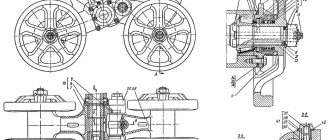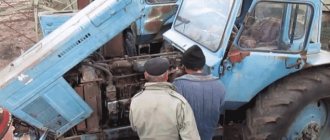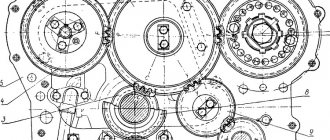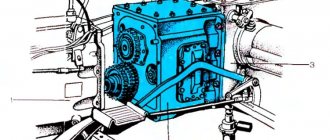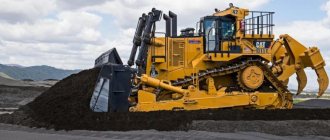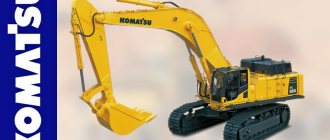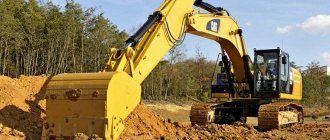How to drive a tractor?
Persons who have completed a training course in the direction “Fundamentals of control and traffic safety of tractors” are allowed to operate the tractor.
Before moving on to driving the tractor, a number of preparatory works are carried out:
- Check the serviceability of tractor components;
- Measure tire pressure;
- If there is attachments on the tractor, visually inspect the tow bracket;
- Remove the casing from the tractor power unit to ensure the proper condition of the battery, cooling system and radiator;
- Wear comfortable clothes and shoes, avoiding loose hair and jewelry;
- The driver's seat settings are adjusted to the height and weight of the operator. With your back resting on the seat, your hands should have free access to the tractor controls, and your feet should have free access to the pedals.
The tractor control process occurs as follows:
- They start the engine and begin to move away - the first attempt to move begins with a warm engine. To do this, reduce the fuel supply, turn off the clutch handle, select a working gear, increase fuel consumption and move the clutch pedal to the on mode;
- When the tractor has moved, they begin to accelerate it to the required speed - they reduce the fuel supply, disengage the clutch, set the desired mode on the gearbox, smoothly engaging the clutch;
- To make a turn at the end of acceleration and pull the plow out of the ground, the accelerator is set to minimum feed;
- Controlling the tractor during the first rut - laying the 1st furrow begins with setting a straight trajectory of movement. In flat areas, for this purpose, one pole and a sighting device are used, built into the tractor; for fields with complex geometry, several poles are required that delimit the entire field. On modern tractors, this control issue is solved faster - with the help of GIS technologies;
- When performing the main cycle of work, the tractor driver must constantly “maneuver” between gears – i.e. choose the optimal rhythm of work for a specific agrotechnical task and the characteristics of the cultivated area. So, to move up a slope and on clayey, loamy, gravelly and heavy chernozems, low gears are used, and in the opposite case, high gears;
- Turning and turning on the field is unacceptable with working adapters and at high speed. To turn the tractor on wheeled propellers, reduce the speed to 5 km/h and apply the brakes to the wheel that is in the center of the turning circle. Turning a caterpillar tractor is done only in extreme cases;
- Driving a tractor while going down a slope is an extremely dangerous maneuver, during which the load is shifted from the front wheels to the rear wheels. To perform it without the risk of an accident, reduce the diesel supply, select a low gear and periodically brake the engine;
- In order to drive a tractor with mounted adapters from the PTO without damage to the power plant and with safety for yourself, you must remember to turn off the power take-off when turning and switch them to transport mode - when going uphill. When moving between areas, it is advisable to disconnect the PTO shaft shank from the cardan drive.
These requirements apply to both factory models and homemade tractors from Niva or Oka.
Crankcase and supercharger
Gear shift diagram on the MTZ-82 tractor
The MTZ-82 gear shift scheme uses an oil sump (sump) with a volume of 15 liters. It is equipped with two gears, has a durable support platform with spacers and connecting cups in the side segments. They are equipped with bushings that act as seals and prevent oil from escaping. During operation, the bushings wear out and must be periodically replaced.
The pumping mechanism consists of a set of disks, between which rigid gaskets are installed. The stands on which the device is mounted are equipped with small protrusions, and the lower support element is rigidly attached.
The injection mechanism operates in difficult conditions and requires periodic maintenance. It is necessary to regularly remove sediment present in the oil and small metal particles that appear during the friction of moving elements.
How to start a tractor?
Proper starting is the key to the successful functioning of any unit. Let's consider it using the example of the famous "Belarus" - MTZ-320.
Before starting the tractor, a set of preparatory work is carried out (filling the gas tank, opening the fuel tap, pumping it up, checking the lubricant and coolant levels).
Start the engine in the following sequence:
- Remove the tractor from the handbrake;
- The gearshift knob is switched to “neutral”;
- The manual throttle switch is set to max. mark;
- Press the mass button;
- Squeeze the clutch;
- The gearshift knob is shifted to the left all the way, holding it there until the engine turns on;
- The starter toggle switch is set to mode I, and smoothly switches it to mode II so that in total its work is 10 s;
- Remove your foot from the clutch and loosen the gearbox toggle switch;
- Let the engine run for 5 minutes and move off, continuing to control the tractor. If it still does not start, the repeated starting procedure begins no earlier than after 2 minutes.
How to start a tractor from the starter?
T.N. “Puskach” is an autonomous starting motor that is equipped with most Soviet tractors.
To start it you need:
- Open the fuel tap;
- Forcefully pump gasoline or diesel into the carburetor unit;
- Close the air damper completely;
- Using the decompression valve, direct fuel into the cylinders;
- Close the gas tap;
- Tighten the starter cord into the groove on the flywheel of the starter and wrap it around the flywheel in a clockwise direction (relative to the flywheel;
- Hold the other end of the cable firmly in your hands, avoiding winding, which can cause injury;
- Pull the cord towards yourself, which should be followed by the hum of the starting motor. If this does not happen, the procedure is repeated several times. Often, this requires first removing fuel residues from the crank chamber and purging it;
- If the start has occurred, give the starter a few minutes to warm up, after which they proceed to the start of the main power plant.
Starting the main motor begins with:
- Transferring the friction clutch to an inoperative state;
- Moving the clutch lever away from you to the extreme left or right mark. This will eliminate slipping and malfunctions;
- When the first crankshaft rotations occur, fuel is supplied to the cylinders. If they are absent, the starter gear is connected to the flywheel ring;
- When the main engine has started working, the starter is turned off - the magneto is inactivated with the button, the fuel supply valve is turned off;
- They warm up for a few minutes at low speeds, after which they move off and begin driving the tractor.
Comprehensive information on this matter is contained in the video.
Purpose and functions of the gearbox plunger and oil seal
Among other elements, the MTZ-82 gear shift circuit contains a plunger with a switch. The blocker is equipped with a gearbox, cups and plunger disks, and relatively thin linings.
The oil seal ensures the tightness of the device and prevents oil from escaping from the housing. It is installed above the block and is driven by the transmission gear. The connection to the shaft is made through a rod. The upper part of the device contains an adapter with working bushings.
Planetary gearbox PTO MTZ-82
Primary shaft
The gearbox of the MTZ-82 tractor has an aggregation with the primary power take-off shaft. It is installed horizontally and is connected at one end to the clutch basket (release plate), and at the other to the secondary shaft coupling. The primary shaft is supported by two bearings. It is equipped with longitudinal teeth on which gears of 3, 4 and 5 speeds are installed. In addition, the input shaft is connected to the creeper using a gear drive.
The design of the transmission does not allow for the input shaft to operate in the neutral position. The device operates only when the synchronous or independent drive is switched on.
MTZ-82 PTO diagram
Maintenance of the MTZ-82 gearbox
The design of the MTZ-82 gearbox has many moving and rubbing parts. Trouble-free operation of all elements is possible only if they are in proper condition, timely technical inspection, and abundant lubrication of all parts. The following malfunctions may occur from irregular maintenance:
Possible malfunctions of the MTZ-82 PTO
- Creaking noise when changing gears.
- Increased lining clearances.
- There is play in the gear shift lever, leading to incomplete or involuntary gear engagement.
- Extraneous noise, grinding or creaking in the box during operation, indicating a violation of the interaction of the elements.
A technical inspection of the gearbox should be carried out once a month. This allows you to increase the service life of the gearbox and rear axle, and ensure appropriate operating conditions for all structural elements. Regular inspection will allow you to promptly detect signs of emerging faults and take measures to eliminate them, without leading to premature major repairs.
Video on the topic: Test drive and review of the Belarus MTZ-82 tractor
Publications on the topic
We learn how to repair the K-700 tractor transmission
Features of diagnostics and repair of the KamAZ 5320 gearbox
Features of the YaMZ-236 gearbox design
Reverse gear design
The reverse gearbox is a unit installed between the clutch and the gearbox. Performs the function of quickly changing the direction of movement back and forth without changing the gear ratio. Simply put, at the same speed you can move forward or backward, which allows you to use the “shuttle” mode.
The design of the reverse gearbox consists of two groups:
MTZ-82 gearbox design
- Mechanical transmission unit.
- Reverse gear control.
The first group consists of a set of gears that transform (change direction) the power flow. The second group ensures timely activation or deactivation of a certain operating mode, allowing you to move forward or backward. In the MTZ-82 gear shift circuit, the action of the reverse gearbox is an important and responsible function that makes it possible to instantly change motion, which is often required in difficult field conditions.

